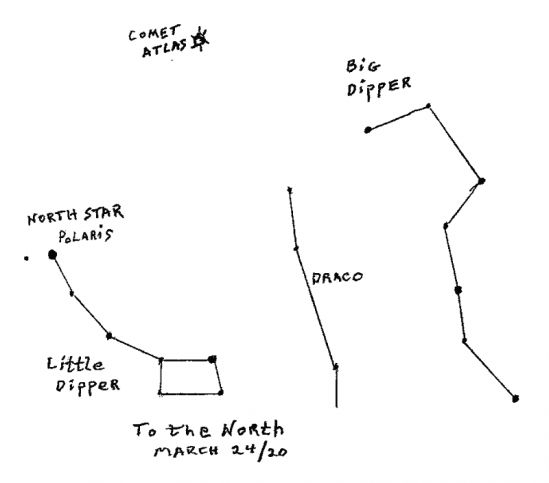Fred Barrett | Apr 01, 2020
In these times of isolation and distancing, there’s still an activity that provides plenty of fresh air, awe and delight. Observing the night sky can be done solitary or shared at a safe talking distance from others without diminishing the enjoyment. A caution: be careful about sharing equipment without careful cleaning between users.
There’s a comet in the sky. Looking to the North, Comet Atlas can be found above and to the left of the Big Dipper. Refer to the attached diagram to help you find it. It’s thought to have an icy core only a few kilometers wide but as it approaches the Sun, its atmosphere of boiled off volatile gases and dust has expanded to a diameter half as wide as the Sun. Atlas is about 1 AU from Earth right now (1 AU is equivalent to the distance between the Earth and the Sun). By mid May it will loop in closer to Earth and dip below the orbit of Mercury. Its coma (atmosphere) will balloon hugely as the Sun’s intensity heats it up even more. It might even become bright enough to see during the day! But there could be a catch. It may gas out so much that it might literally run out of gas and dust and possibly disintegrate. Opinions vary as to whether that will happen but its green glow is now easily visible through a small telescope and will soon be observable through binoculars. I’ll give you an update in May whatever happens.
We also have a nice medium size meteor shower in April and conditions are perfect. The Lyrid shower peaks early morning on April 22nd when the Moon is almost new. It is most active from April 14th to the 30th. Looking east, its radiant is above bright Vega in the constellation Lyra. Lyra can be found above the great cross that forms the body and wings of the constellation Cygnus, the swan. An observer can expect about 15 to 20 meteors per hour and meteors may appear anywhere in the sky.
I hope you are enjoying a very bright Venus in the west. In early April it is nestled nicely in the Pleiades and moves east towards the Hyades star cluster as the month progresses. It will be at its brightest April 27th.
On April 9th look to the southwest horizon about an hour before dawn. Mars, Saturn and Jupiter form an angled line sloping upwards left to right. Get up early or have a look before going to work.
Here’s the month in review.
April 1st : First quarter Moon.
April 7th : The Moon is at perigee (closest) – 354,800 kilometers. It’s also a full Moon. This Moon is called the Full Pink Moon. Native peoples named it after a pink flower that bloomed in April. It’s also known as the Full Grass Moon. It’s time to get out the lawn mower and get it tuned up for heavy pushing!
April 14th : Last quarter Moon. The Moon passes 2 degrees south of Jupiter at 2pm EDT.
April 15th : The Moon passes 2 degrees south of Saturn at 5am EDT.
April 16th : The Moon passes 2 degrees south of Mars at 1am EDT.
April 20th : The Moon is at apogee (furthest) – 404,100 kilometers.
April 22nd : The Lyrid meteor shower peaks. New Moon occurs.
April 27th : Venus is at its brightest – magnitude -4.7.
April 30th : First quarter Moon.
Stay safe, stay separate and enjoy the sky. That’s a wrap. Keep looking up!
“The Beginner’s Observing Guide by Leo Enright is an invaluable companion for adventures in the sky. It also contains useful star charts. It can be ordered from the Royal Astronomical Society of Canada at www.rasc.ca/publications. A subscription to our very own excellent Canadian astronomy magazine “SkyNews” can be arranged at the RASC website as well.
Let me know how your observing has gone this month, especially anything unusual. I enjoy the feedback. If you have any questions or suggestions you can contact me through this paper or email me at This email address is being protected from spambots. You need JavaScript enabled to view it. . Clear Skies! Fred.
More Stories
- No Winner Yet in Catch The Ace But Fundraising Target Met
- South Frontenac Food Bank Opens Second Location in Battersea
- Sharbot Lake Pentecostal Church Anniversary - 1925-2025
- Frontenac Holistic Health Fair - September 20 At Storrington Centre
- Odd Year For Real Estate - But Sales Are Steady Year Over Year
- 193rd Kingston Fall Fair
- Kim Phuc - the Napalm Girl - To Visit Flinton In November
- South Frontenac Council - September 2
- Sticker Shock - EV Charging Station To Cost North Frontenac Township
- 30th Anniversary Verona Car Show

